Cruise Origin is the electric, driverless taxi of tomorrow
Cruise's boxy, electric people mover ditches the steering wheel and the driver's seat, optimizing for spacious, safe and autonomous urban ride hailing.

- North American Car, Truck and SUV of the Year (NACTOY) Awards Juror
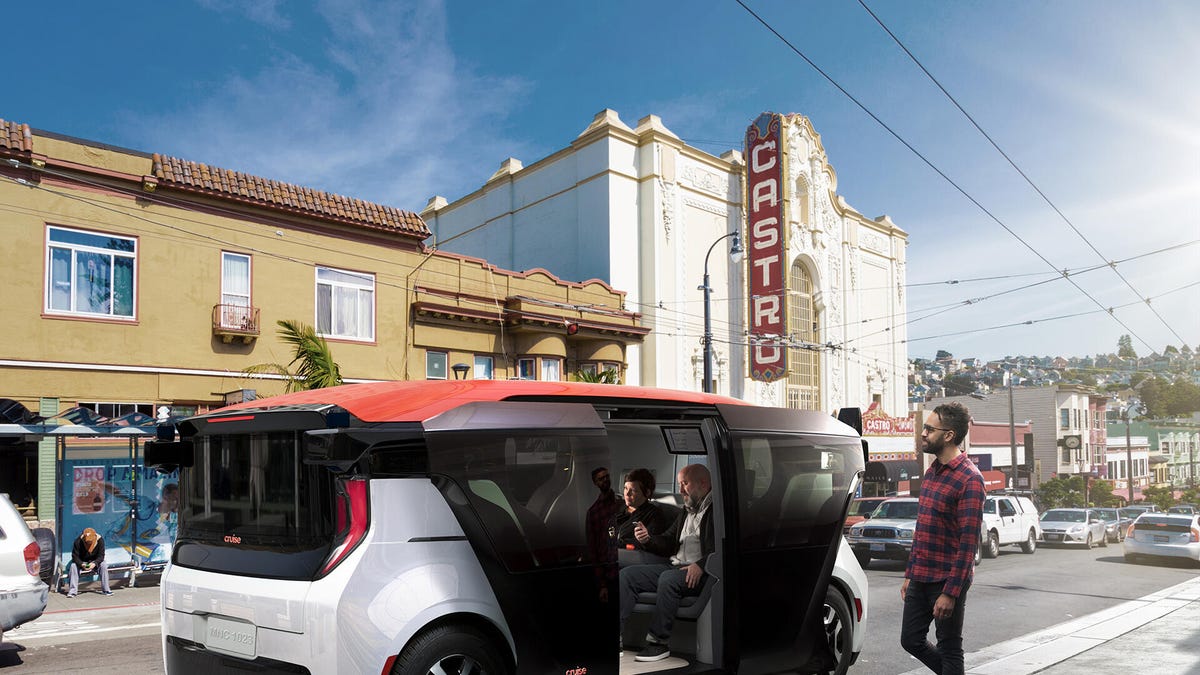
Autonomous vehicle developer Cruise debuted the Cruise Origin, its new vision for a totally driverless, emissions-free vehicle of tomorrow, at an event in San Francisco Tuesday night. And yes, it's another futuristic box-on-wheels that I really, really hate looking at, but this autonomous people mover isn't supposed to be sexy. It's meant to be a safe, spacious and city-friendly autocab. The Origin is a driving appliance or, perhaps more specifically, a not-driving appliance built to power an autonomous ride-hailing service sometime in the near future.
Cruise knows a thing or two about ride-hailing. It's been testing a fleet of autonomous Chevrolet Bolt EVs for the past three years and running an autonomous Cruise Anywhere beta test limited to its employees since 2017 -- albeit with a human safety driver on board. Last year, Cruise showcased a fourth-gen version of its self-driving Bolt with no steering wheel , not-so-subtly hinting at its ambitions of Level 5 autonomy .
In many ways, the Cruise Origin is the culmination of those ambitions. Details about the vehicle are still sparse, but here's what we learned at the unveiling event tonight.

The Origin has no driver's seat, just two bench seats that face inward for up to six passengers.
Powering the Origin is a GM-sourced electric motor with the battery pack slung beneath the passenger compartment. We don't have power figures and we don't know range, but these metrics aren't really the point of a low-speed urban shuttle. You probably didn't think about the fuel economy and horsepower of the last Uber or taxi you hailed, and Cruise is smartly reckoning that you probably won't care about the range of the Origin if it can get you where you're going. "This is a service you share, not a product you buy," as Cruise CEO Dan Ammann said multiple times during the evening.
The electric powertrain frees up room in the cabin, making sure that as much of the Origin's fairly compact footprint gets dedicated to the passengers as possible. The upright, boxy profile does the rest. Sliding doors help prevent collisions with cyclists and pedestrians when loading or unloading -- though they'll still have to dodge the people who come spilling out of them at each stop. Inside you'll find generous seating and legroom for four passengers with the folding center armrests deployed or up to six souls if you don't mind scrunching in.

Hyundai partners up with Uber Elevate, debuts air taxi concept S-A1
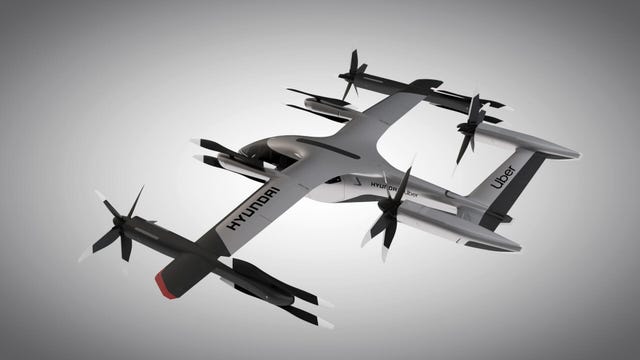
The Origin has no steering wheel, no pedals and no driver seat. It's designed around complete autonomy with the passengers facing inward toward one another. Facing outward is Cruise's suite of sensors and autonomous software, which the company has been honing and developing over three years and millions of miles of testing in San Francisco, Detroit and Scottsdale, Arizona.
You've got your familiar lidars and radars and a new, owllike stereoscopic optical sensor suite that rapidly swivels back and forth, locking onto, recognizing and tracking multiple pedestrians, cyclists and other important details. The Origin features four of these swiveling all-seeing arrays -- one for each vehicle corner -- which can also see in pitch darkness, presumably on the IR spectrum. Cruise calls this blend of sensors Superhuman Sensing, playing up the advantages they offer over human drivers who can only really look in one direction at a time when they're not being distracted.
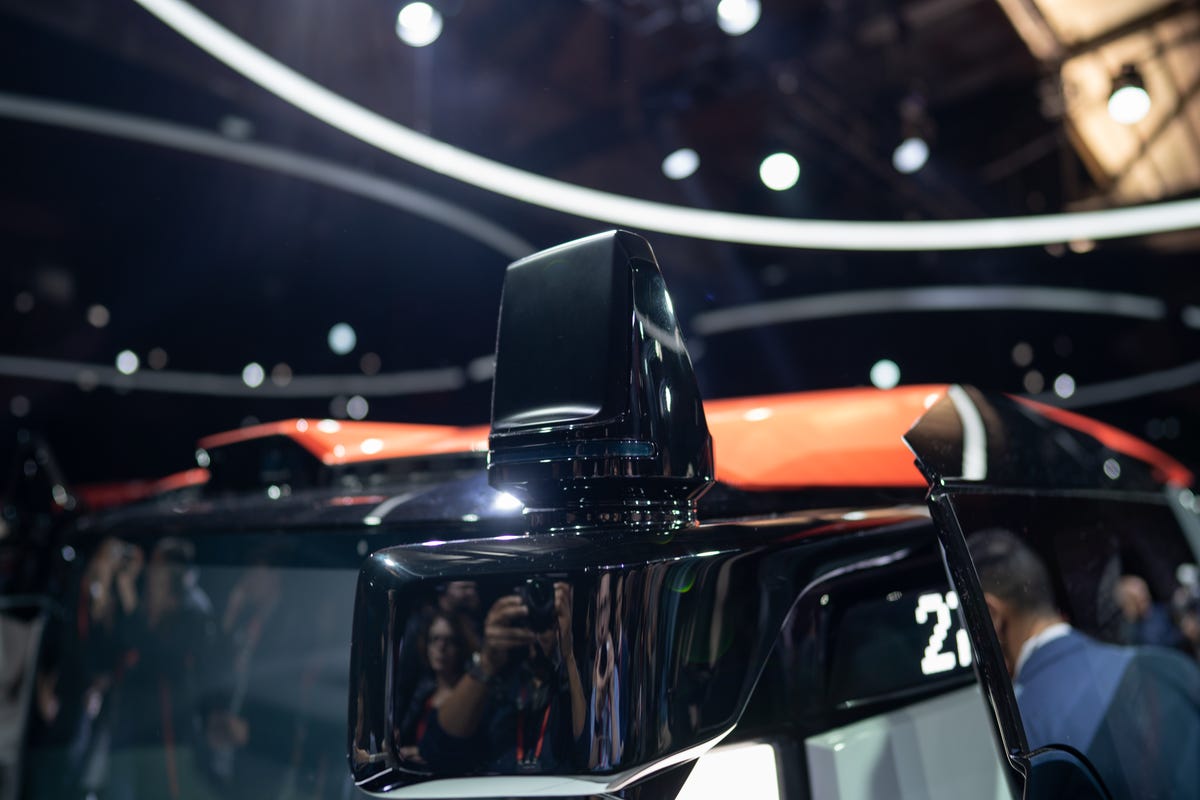
There are four of these swiveling stereoscopic camera pods, one for each corner.
Eventually, Cruise plans to build a whole lot of these things, so they've gotta be somewhat economically feasible and scalable. The Origin is built around a modular design that should make the sensors easy to repair and upgrade as new sensor technologies develop. Cruise reckons it can build an Origin for about half as much as a traditional EV SUV and keep its vehicles on the road for over 1 million miles each. If they can achieve such a service life, it'll be a solid return on investment. The modular design also means that Cruise could eventually outfit Origins as delivery vehicles or for other purposes, putting the boxes on wheels to work while the city sleeps.
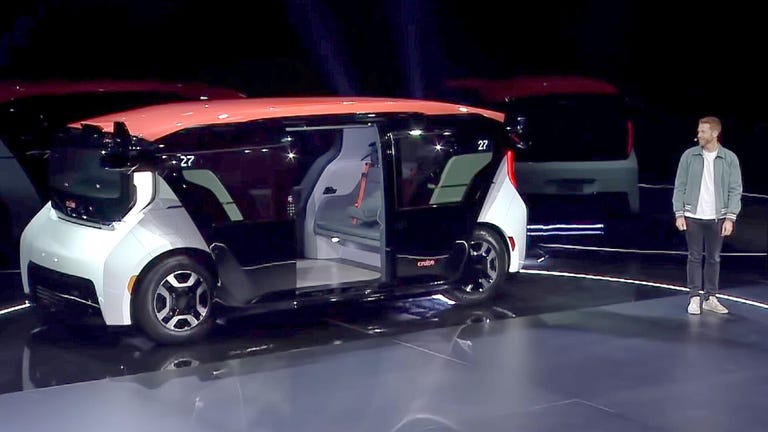
On the consumer side, Cruise isn't ready to talk about how much its eventual ride-hailing service will cost, but estimates that driverless cabs like the Origin can save passengers up to $5,000 per year compared with traditional human-piloted ride-hailing services or owning a car, eliminating parking costs, personal vehicle depreciation, insurance, paying and tipping the driver or wasting time driving yourself. Of course, until we know how much an Origin ride will cost, we can't do the math to see if we agree.
Cruise also isn't ready to talk about when and where the Origin will be produced -- though it does seem confident that it can and will build it. And questions regarding the time frame and launch window for the ride-hailing service that the Origin will support are unfalteringly met with a smile and a "Stay tuned" from Cruise's representatives. I have been told that we can expect more details to trickle out over the coming weeks, so we'll be following this the story of Cruise and its Origin as it develops.
- Mobile Site
- Staff Directory
- Advertise with Ars
Filter by topic
- Biz & IT
- Gaming & Culture
Front page layout
Driverless cars —
Gm seeks us approval to deploy self-driving car without a steering wheel, nhtsa to review safety of driverless cruise origin before possible 2023 deployment..
Jon Brodkin - Feb 21, 2022 6:21 pm UTC
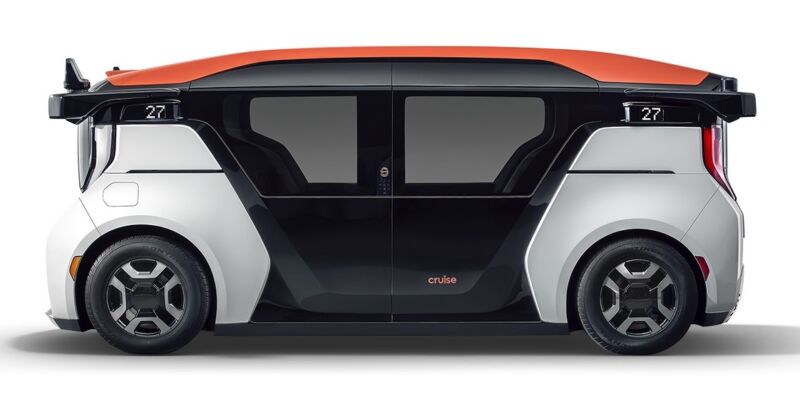
GM's Cruise subsidiary has petitioned the National Highway Traffic Safety Administration (NHTSA) for permission to put the driverless Cruise Origin into commercial service. Cruise announced the filing of its petition for approval on Friday, saying the car is "a zero-emission, shared, electric vehicle that has been purposefully designed from the ground up to operate without a human driver. This means it does not rely on certain human-centered features, like a steering wheel or a sun visor, to operate safely."
Cruise said its petition, filed together with parent company GM, "demonstrates how the Origin achieves safety objectives of existing standards and helps enable future AV [autonomous vehicle] regulations." The vehicles will be manufactured at GM's " Factory ZERO " in Michigan, Cruise's announcement said. "Production is expected to begin in late 2022 in Detroit at a GM factory with vehicles delivered in 2023, Cruise said Friday," according to Reuters .
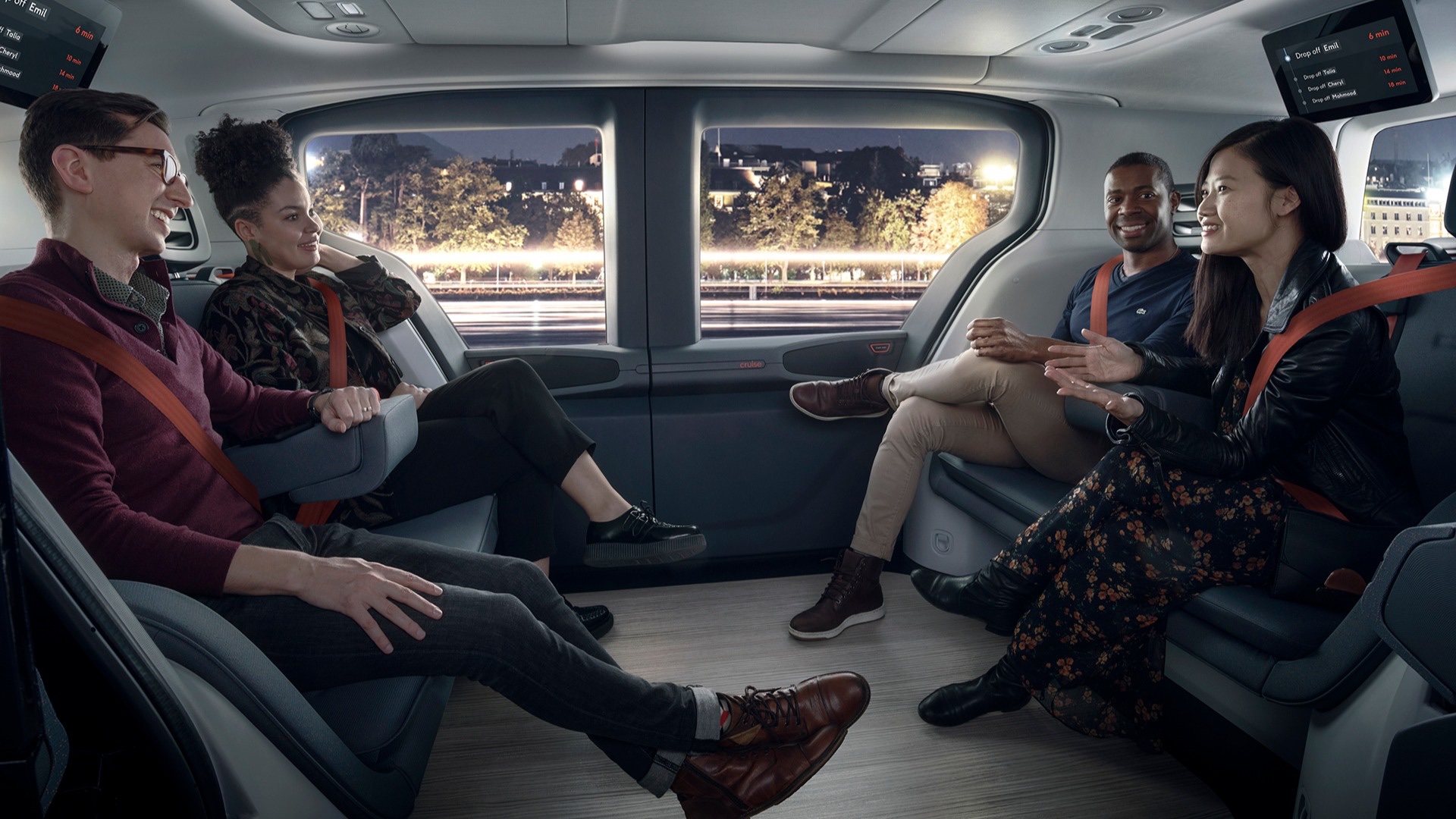
US law allows companies to seek temporary exemptions from safety rules to deploy up to 2,500 vehicles. GM previously sought an exemption for an earlier design based on the Chevy Bolt; the NHTSA took public comment on the request for an exemption in early 2019, and GM withdrew the petition in 2020.
Cruise taking sign-ups in San Francisco
Three weeks ago, Cruise started taking sign-ups for people who want to take a ride in a driverless car in San Francisco. That limited deployment was authorized by California's Department of Motor Vehicles . It uses the self-driving car based on the Chevy Bolt, as the Cruise Origin hasn't been deployed yet.
Alphabet's Waymo division began providing its self-driving ride-hailing service in San Francisco in August 2021 . Waymo was already offering the service in the suburbs of Phoenix, Arizona . Several other companies are planning driverless cars as well.
GM is the majority owner of Cruise, which also has investments from SoftBank , Honda , Microsoft , and Walmart . Here's another view of the Cruise Origin from Friday's announcement:
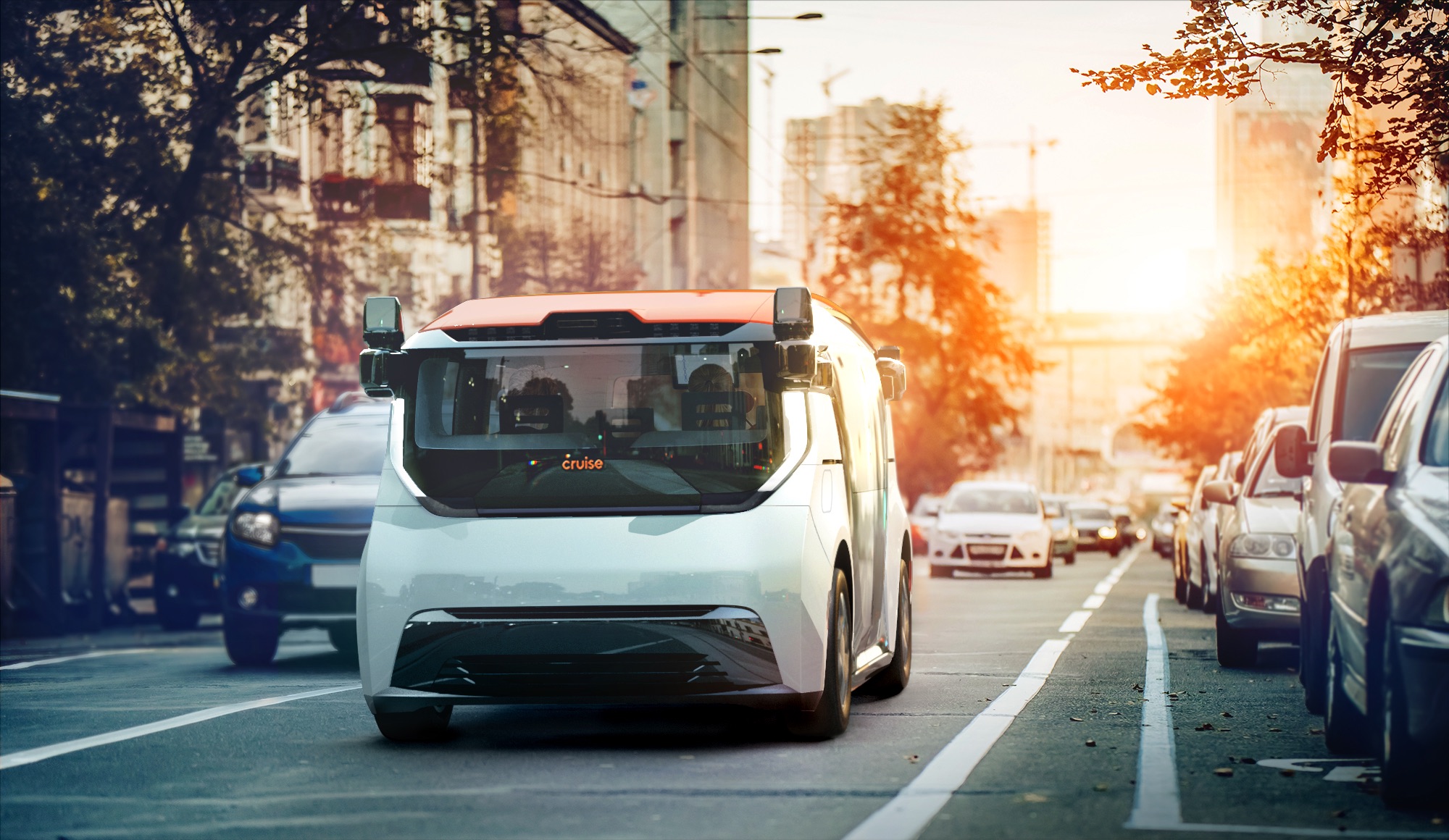
reader comments
Channel ars technica.
GM’s plan to deploy self-driving Cruise Origin on hold as feds weigh exemption request

General Motors' mission to get 5,000 self-driving Cruise Origin vehicles in cities nationwide hangs on whether federal regulators will grant the automaker's request to exempt the vehicle from federal safety standards.
GM plans to start building the Origin at Factory Zero in Detroit/Hamtramck this year but needs approval from the National Highway Traffic Safety Administration to put the vehicles on the roads. The Origin is a small bus-like vehicle that will transport up to six people without a driver. It operates through autonomous technology and has no manual steering controls or pedals.
"The Cruise Origin is on track to start production this year," said Aimee Ridella, GM spokeswoman. But she is careful to note, "pending government approval."
That government approval depends on how satisfactorily GM answers some big questions NHTSA is asking about the operational safety of the self-driving cars Cruise already has on roads now. In some cases, those cars have caused traffic backups and other public safety disruptions.
A regulatory framework is needed first
NHTSA regulates safety guideline standards to reduce auto crashes for regular motor vehicles but regulating autonomous vehicles is new for the organization. NHTSA's approval process for vehicles that do not have a human driver, such as the Cruise Origin, is required because current federal safety standards are written for cars that have a steering wheel and pedals. A delay in approval could delay GM putting Origins on the road and making money off them.
But no framework exists to guide NHTSA at the moment even though lawmakers such as U.S. Rep. Debbie Dingell, D-Ann Arbor, is pushing to get one in place so that companies such as Cruise can continue to make technological advancements that ensure safety, yet keep the U.S. competitive with other countries. China, for example, has made big investments in autonomous technology.
"There's a lot of confusion and uncertainty that's arisen out of this vacuum of employing self-driving vehicles nationwide and that's why it's important to set a framework for the rules of the road for autonomous vehicles," Dingell said.
Dingell wants to help get legislation in place that provides a framework to regulate autonomous vehicles because, she said, "I want these things built at Factory Zero because it means 2,000 union jobs. But we have to update the laws. Right now, current motor vehicle safety regulations require there be a driving wheel, accelerator and a brake, among other things. So what does the AV need? We need to update the motor vehicle standards.”
Dingell said her No. 1 priority is that those standards ensure that self-driving cars are safe.
What happens to Factory Zero jobs if NHTSA says no?
GM is asking NHTSA to make an exception and let it get its cars on the road and then even use the data from how they perform to help shape future regulations, according to a February 2022 blog post from Rob Grant, senior vice president, government affairs and social impact for Cruise.
As the majority owner of San Francisco-based Cruise, GM has been operating modified self-driving Bolts as a taxi service in San Francisco since June, when California regulators allowed Cruise to charge for rides during limited hours and locations. GM expects to eventually see revenue from collecting rider fees, particularly if the automaker can expand service.
But Cruise needs to expand its operations to other cities if it is to deliver on its goal of $1 billion in revenue by the end of 2025. The self-driving startup has been costing GM $1 billion to $2 billion a year in capital to operate.
So what happens if NHTSA denies GM's petition? GM can build the Origin, it just can't put them on roads, said Sam Abuelsamid, principal analyst for E-Mobility at Guidehouse Insights in Detroit.
"It’s not like you’ll lose a bunch of jobs in Detroit," Abuelsamid told the Free Press. "It’s more about the viability of the Cruise business as a whole. Cruise does not want to be deploying modified Bolts on a large scale, it’s not an efficient way to run the AV business. They want to expand and deploy their service in multiple locations and the best way to do that is with the Origin."
NHTSA is in no hurry
Abuelsamid said the volume of Origins that GM plans to build over the next few years is “pretty trivial compared to what they plan to build in trucks" at Factory Zero, which is why its impact on jobs is minimal. GM builds the GMC Hummer EV pickup, the GMC Hummer SUV and will soon start making the 2024 Silverado EV, all at Factory Zero.
That's a good thing because Abuelsamid said NHTSA is in no hurry to give its blessing to Cruise, or for that matter any other AV companies such as Veoneer's Zeus autonomous driving system or Tesla's full-self driving system, which a driver blamed for abruptly stopping his car and causing an eight-car pileup on the Bay Bridge in San Francisco last fall.
“They’re just taking a very slow approach to everything,” Abuelsamid said of NHTSA.
A NHTSA spokesperson declined to comment for this article because GM's request to NHTSA is still under consideration. But on Feb. 16, NHTSA did crack down on Tesla. It pressed the electric carmaker to recall nearly 363,000 vehicles with its “Full Self-Driving” system because of various road violations, according to AP .
Abuelsamid said he is "fairly confident" that Cruise's self-driving cars will pass the federal crash test standards, but he believes that NHTSA does not want "to rush approving any AVs" for exemption from safety standards "because they don’t understand the problems and how to regulate these systems."
How the Origin differs from the Bolt
Cruise has said its autonomous cars work and are safe. But the Origin, unlike the modified Bolt, will not have human controls such as a steering wheel and pedals. That's why GM petitioned NHTSA to grant it an exemption from federal vehicle safety standards.
Cruise is ready to proceed as planned and add 5,000 Origins to U.S. roads over the next few years.
“Pending approval of our petition ... it is ready to roll off the line at GM's Factory Zero in Detroit, where it will contribute to 2,200 union jobs," said Hannah Lindow, Cruise spokeswoman. "We look forward to working with NHTSA to ensure the safe and responsible deployment of this technology.”
But, in January, NHTSA sent a series of questions to GM asking the automaker to disclose the software and hardware used in the Origin, and the safety record and operational snafus experienced with the Bolt robo-taxis in San Francisco so far, specifically why a "cluster of 13 Cruise vehicles ... stopped in the same place. What remedies or software/hardware modifications has GM made to prevent this from occurring again?" NHTSA asked GM.
NHTSA also wants to know what kinds of testing GM is doing with the cars at higher speeds such as 60 mph and beyond and to document the risk differences at such speeds.
GM and Cruise are working to answer NHTSA, a person familiar with Cruise but not authorized to speak publicly about these specific issues told the Free Press. As to the 13 Cruise cars stopping, that was a technical issue which has been identified and resolved shortly after the incident occurred in June, the person familiar with Cruise said. Those 13 vehicles were recovered through a combination of remote assistance and manual retrieval, the person said.
San Francisco officials want to hit pause
In the meantime, some San Francisco officials want to apply the brakes on further expansion by Cruise, fearing that a larger fleet would exacerbate existing safety and traffic concerns.
In April, a self-driving Cruise car stopped in a travel lane, blocking a San Francisco Fire Department vehicle on its way to a three-alarm fire, according to a report in The Verge . Months later, a Cruise AV ran over a fire hose that was in use. There have been three incidents, according to The Verge report, of Cruise cars calling 911 about unresponsive passengers. When emergency services arrived, they found that the rider had merely fallen asleep.
One of the groups that wants a slower rollout of AVs is the San Francisco County Transit Authority (SFCTA).
"We share the hope that autonomous vehicles will someday improve street safety, access, and operational efficiency in San Francisco and elsewhere," Eric Young, spokesman for SFCTA, told the Free Press. "Based on our experience and observations, we are seeking assurances that autonomous vehicle companies have addressed the issues that caused their vehicles to obstruct traffic lanes and key intersections, and to demonstrate that their driverless vehicles can operate safely and reliably in San Francisco, before they are granted permission to expand their activities in our city."
Lindow defended Cruise, saying its safety record is publicly reported and includes millions of miles driven in a complex urban environment without any life-threatening injuries or fatalities.
"We’re proud that the overwhelming majority of public comments on our regulatory filings –– including from advocates in the disability community, small businesses and local community groups –– support expanding Cruise’s all-electric driverless service," Lindow said.
Lindow declined to comment on what Cruise or GM would do if NHTSA denies the petition.
Cruise's viability depends on expansion
In September, Cruise took more modified Bolt robotaxis to Phoenix and Austin, Texas , where it offers rides to limited passengers. Cruise's total fleet consists of about 300 self-driving Chevrolet Bolts across all three cities, Lindow said.
Cruise's fleet is a drop in the bucket when you consider there are about 30,000 Uber and Lyft vehicles in operation in San Francisco and about 100,000 in New York City, Abuelsamid said. Excluding taxis and other smaller players, the ride hail market in the United States was about a $45 billion industry as of last year, he said.
That's why building those 5,000 Origins at Factory Zero and getting them on the road is key to Cruise reaching its publicly stated revenue target, Abuelsamid said. And, he said, while hitting $1 billion in revenue is certainly doable, it will likely be nowhere near profitability.
"It’s hard to say how much they might lose in 2025, but the number is almost definitely going to be bigger than that revenue number," Abuelsamid said.
In his math, if Cruise charges the same fares as Uber and Lyft, which is about $2.50 a mile, it needs about 400 million miles with passengers paying that fare to hit $1 billion. To do that will require about 5,500 robotaxis, he said.
"If you conservatively say, 'We’ll put 500 vehicles in each city we operate in,' that’s 10 to 11 cities. Right now they’re in three with about a couple hundred Bolts," Abuelsamid said, adding that expansion to 10 cities by the end of 2025 "is not unreasonable."
He added, "They’ll do whatever it takes to get that approval from NHTSA and it’ll happen eventually. I think, it’s just a matter of time."
Contact Jamie L. LaReau: [email protected] . Follow her on Twitter @ jlareauan . Read more on General Motors and sign up for our autos newsletter .
- Autonomous Cars /
Cruise is back driving autonomously for the first time since pedestrian-dragging incident
The gm-backed firm’s fleet has been grounded nationwide since an incident last year when a pedestrian was dragged by one of its driverless vehicles..
By Andrew J. Hawkins , transportation editor with 10+ years of experience who covers EVs, public transportation, and aviation. His work has appeared in The New York Daily News and City & State.
Share this story
:format(webp)/cdn.vox-cdn.com/uploads/chorus_asset/file/25445870/1238159620.jpg)
Cruise’s autonomous vehicles are officially back on the road and driving autonomously for the first time since one of its driverless vehicles dragged a pedestrian over 20 feet in San Francisco.
Cruise said last month that it would resume testing with manually driven vehicles focused on mapping and gathering road information — minor tasks for a company with as many autonomous miles as Cruise. But Cruise needs to show local officials that it is suitably apologetic for the pedestrian-dragging incident by going slow and talking a lot about safety and trust . The company is deploying its vehicles in Phoenix, Arizona, which has long been a hotbed for autonomous vehicle testing.
Cruise needs to show local officials that it is suitably apologetic
Cruise spokesperson Tiffany Testo said the company is deploying only two autonomous vehicles with safety drivers behind the wheel. In addition, the company has eight manually driven vehicles in the city. Eventually, the service area will “gradually expand” to include Scottsdale, Paradise Valley, Tempe, Mesa, Gilbert, and Chandler — “measured against predetermined safety benchmarks.”
Cruise’s slow return to the road is noteworthy, given the huge hurdles facing the company in the wake of the October incident. Regulators accused the company of misleading them about the nature and severity of the incident, in which a pedestrian was dragged over 20 feet by a driverless Cruise after first being struck by a hit-and-run driver.
Several top executives have since left the company, including founder and CEO Kyle Vogt, and around a quarter of employees were laid off . GM has said it will reduce its spending on Cruise. And an outside report found evidence that a culture of antagonism toward regulators contributed to many of the failings.
With all that was going wrong, GM could have pulled the plug on Cruise . Indeed, the robotaxi company has been a huge financial drag on the automaker, losing $3.48 billion in 2023. Other car companies have pulled funding for their autonomous vehicle projects for much less. But instead, GM is sticking with it — and Cruise is gearing up to get back on the road — which is a sign that despite all its setbacks, the automaker is still intent on jockeying with Waymo, Tesla, and others for a spot in the race toward an autonomous future.
iPhone owners say the latest iOS update is resurfacing deleted nudes
Google sheets’ new formatting feature has excel switchers excited, the mac vs. pc war is back on, google opens up its smart home to everyone and will make google tvs home hubs, samsung mocks apple’s crushing ipad pro ad with its own ‘uncrush’ pitch.
More from Transpo
:format(webp)/cdn.vox-cdn.com/uploads/chorus_asset/file/25445520/Large_16567_Three_rowID.Buzz.jpg)
VW releases battery and motor details for upcoming ID Buzz electric microbus
:format(webp)/cdn.vox-cdn.com/uploads/chorus_asset/file/25445305/1247340886.jpg)
Amazon’s robotaxi company is under investigation after two crashes with motorcyclists
:format(webp)/cdn.vox-cdn.com/uploads/chorus_asset/file/25442284/2152143756.jpg)
Biden really, really doesn’t want China to flood the US with cheap EVs
:format(webp)/cdn.vox-cdn.com/uploads/chorus_asset/file/24333940/ocean_windows_open.jpg)
Fisker’s brakes can’t catch a break
Cruise unveils Origin, an electric driverless vehicle designed for sharing

Cruise unveiled Tuesday evening a “production ready” driverless vehicle called Origin, the product of a multi-year collaboration with parent company GM and investor Honda that is designed for a ridesharing service.
The shuttle-like vehicle — branded with Cruise’s trademark orange and black colors — has no steering wheel or pedals and is designed to travel at highway speeds. The interior is roomy, with seats that face each other, similar to what a traveler might find on some trains. Each seat is meant to accommodate the needs of an individual, with personal USB ports, CTO and co-founder Kyle Vogt noted during the presentation. Digital displays are located above, presumably to give travelers information about their rides.
The doors don’t hinge outward, Vogt added. Instead, he said, “they slide open, so bikers are safer.”
Splashy looks aside, the Origin is meant to show Cruise’s muscle and intent to deploy an autonomous ridesharing service at scale. When and how that will happen are the important questions left unanswered.
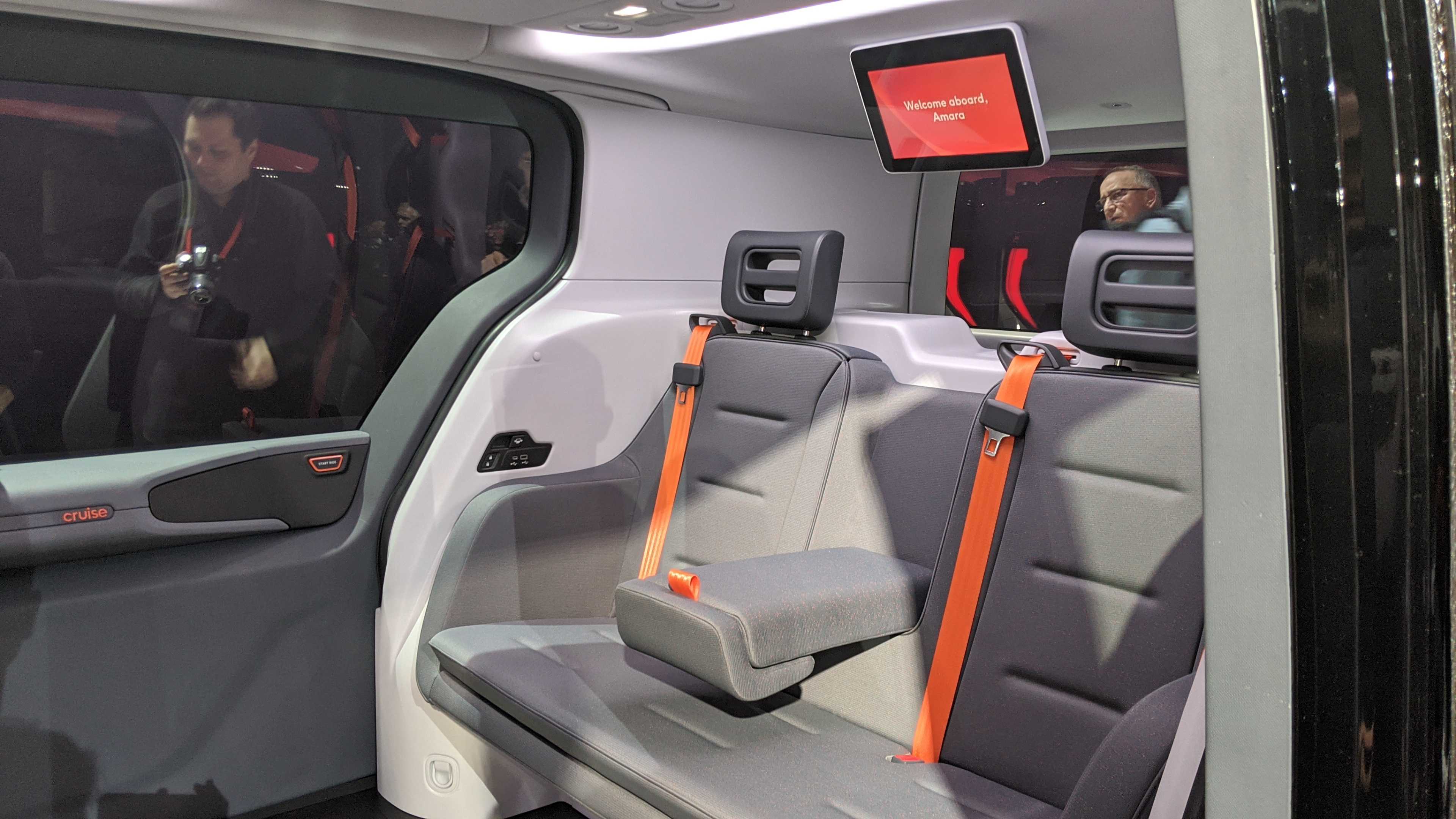
CEO Dan Ammann stressed that the vehicle is not a concept, but instead is a production vehicle that the company intends to use for a ridesharing service.
However, don’t expect the Origin to be on public roads anytime soon. The driverless vehicle doesn’t meet U.S. federal regulations known as FMVSS, which specify design, construction, performance and durability requirements for motor vehicles.
For now, the Origin will be used on private, closed environments such as GM facilities in Michigan or even Honda’s campus outside of the U.S., Ammann said in an interview after the presentation.
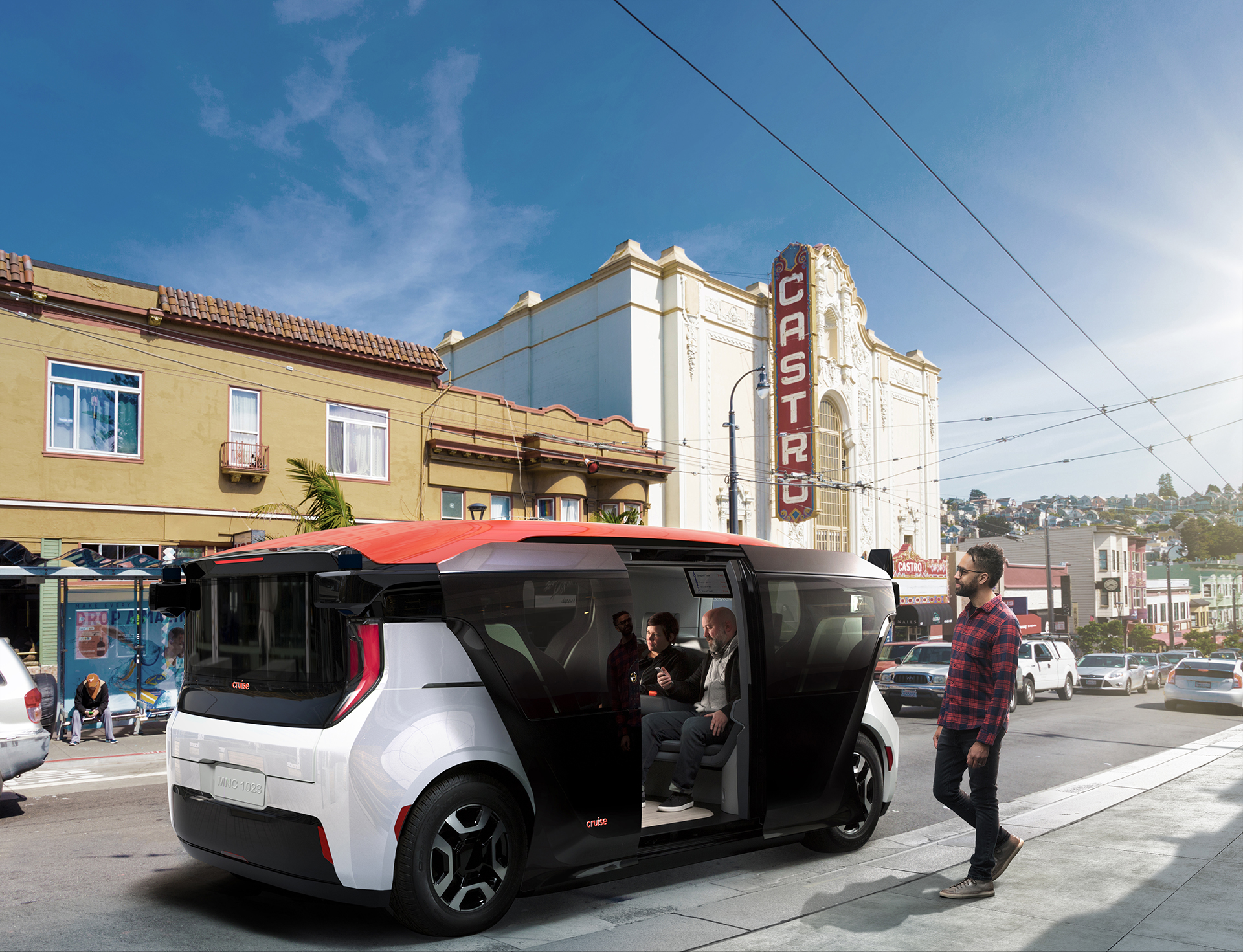
Ammann also emphasized the low cost of the vehicle, which he added is designed to operate 1 million miles.
“W e’ve been just as obsessed with making the O rigin experience as inexpensive as possible,” Ammann said while onstage. “ Because if we’re really serious about improving life, and our cities, we need huge numbers of people to use the C ruise origin. And that won’t happen unless we deliver on a very simple proposition, a better experience at a lower price than what you pay to get around today.”
GM will manufacture the vehicle, although Ammann wouldn’t provide more details on where except to say “you’ll find out in a couple of days.” He did say that the vehicle will be produced “for roughly half the cost of what a conventional electric SUV costs today.”
The reveal offered more clues about Cruise’s hardware development, which has been growing in the past 18 months under the leadership of its vice president of hardware, Carl Jenkins and Brendan Hermalyn, director of autonomous hardware systems.
The vehicle is outfitted with what Vogt called an “owl,” a hybrid sensor assembly that seems to combine camera and radar. The team responsible for developing the “owl” was at the event, and seen posing for photos long after the presentation had ended and most revelers had left.
More TechCrunch
Get the industry’s biggest tech news, techcrunch daily news.
Every weekday and Sunday, you can get the best of TechCrunch’s coverage.
Startups Weekly
Startups are the core of TechCrunch, so get our best coverage delivered weekly.
TechCrunch Fintech
The latest Fintech news and analysis, delivered every Sunday.
TechCrunch Mobility
TechCrunch Mobility is your destination for transportation news and insight.
A US Trustee wants troubled fintech Synapse to be liquidated via Chapter 7 bankruptcy, cites ‘gross mismanagement’
The prospects for troubled banking-as-a-service startup Synapse have gone from bad to worse this week after a United States Trustee filed an emergency motion on Wednesday. The trustee is asking…

Seraphim’s latest space accelerator welcomes nine companies
U.K.-based Seraphim Space is spinning up its 13th accelerator program, with nine participating companies working on a range of tech from propulsion to in-space manufacturing and space situational awareness. The…

OpenAI inks deal to train AI on Reddit data
OpenAI has reached a deal with Reddit to use the social news site’s data for training AI models. In a blog post on OpenAI’s press relations site, the company said…

X pushes more users to Communities
X users will now be able to discover posts from new Communities that are trending directly from an Explore tab within the section.

Mark Zuckerberg’s makeover: Midlife crisis or carefully crafted rebrand?
For Mark Zuckerberg’s 40th birthday, his wife got him a photoshoot. Zuckerberg gives the camera a sly smile as he sits amid a carefully crafted re-creation of his childhood bedroom.…

Strava taps AI to weed out leaderboard cheats, unveils ‘family’ plan, dark mode and more
Strava announced a slew of features, including AI to weed out leaderboard cheats, a new ‘family’ subscription plan, dark mode and more.

Astronauts fall over. Robotic limbs can help them back up.
We all fall down sometimes. Astronauts are no exception. You need to be in peak physical condition for space travel, but bulky space suits and lower gravity levels can be…

Microsoft’s custom Cobalt chips will come to Azure next week
Microsoft will launch its custom Cobalt 100 chips to customers as a public preview at its Build conference next week, TechCrunch has learned. In an analyst briefing ahead of Build,…
Tesla keeps cutting jobs and the feds probe Waymo
What a wild week for transportation news! It was a smorgasbord of news that seemed to touch every sector and theme in transportation.

Sony Music warns tech companies over ‘unauthorized’ use of its content to train AI
Sony Music Group has sent letters to more than 700 tech companies and music streaming services to warn them not to use its music to train AI without explicit permission.…

GrubMarket buys Butter to give its food distribution tech an AI boost
Winston Chi, Butter’s founder and CEO, told TechCrunch that “most parties, including our investors and us, are making money” from the exit.

Bolt founder Ryan Breslow wants to settle an investor lawsuit by returning $37 million worth of shares
The investor lawsuit is related to Bolt securing a $30 million personal loan to Ryan Breslow, which was later defaulted on.

With the end of Workplace, it’s fair to wonder if Meta was ever serious about the enterprise
Meta, the parent company of Facebook, launched an enterprise version of the prominent social network in 2015. It always seemed like a stretch for a company built on a consumer…


Meta Threads is testing pinned columns on the web, similar to the old TweetDeck
X, formerly Twitter, turned TweetDeck into X Pro and pushed it behind a paywall. But there is a new column-based social media tool in town, and it’s from Instagram Threads.…

Google expands hands-free and eyes-free interfaces on Android
As part of 2024’s Accessibility Awareness Day, Google is showing off some updates to Android that should be useful to folks with mobility or vision impairments. Project Gameface allows gamers…

Hacker claims theft of India’s Samco account data
A hacker listed the data allegedly breached from Samco on a known cybercrime forum.

Ireland privacy watchdog confirms Dell data breach investigation
A top European privacy watchdog is investigating following the recent breaches of Dell customers’ personal information, TechCrunch has learned. Ireland’s Data Protection Commission (DPC) deputy commissioner Graham Doyle confirmed to…

Ampere teams up with Qualcomm to launch an Arm-based AI server
Ampere and Qualcomm aren’t the most obvious of partners. Both, after all, offer Arm-based chips for running data center servers (though Qualcomm’s largest market remains mobile). But as the two…

Google I/O was an AI evolution, not a revolution
At Google’s I/O developer conference, the company made its case to developers — and to some extent, consumers — why its bets on AI are ahead of rivals. At the…

Meet the Magnificent Six: A tour of the stages at Disrupt 2024
TechCrunch Disrupt has always been the ultimate convergence point for all things startup and tech. In the bustling world of innovation, it serves as the “big top” tent, where entrepreneurs,…

Khosla Ventures, Pear VC triple down on Honey Homes, a smart way to hire a handyman
There’s apparently a lot of demand for an on-demand handyperson. Khosla Ventures and Pear VC have just tripled down on their investment in Honey Homes, which offers up a dedicated…

TikTok tests 60-minute video uploads as it continues to take on YouTube
TikTok is testing the ability for users to upload 60-minute videos, the company confirmed to TechCrunch on Thursday. The feature is available to a limited group of users in select…

Flock Safety’s solar-powered cameras could make surveillance more widespread
Flock Safety is a multibillion-dollar startup that’s got eyes everywhere. As of Wednesday, with the company’s new Solar Condor cameras, those eyes are solar-powered and use wireless 5G networks to…

Agora raises $34M Series B to keep building the Carta for real estate
Since he was very young, Bar Mor knew that he would inevitably do something with real estate. His family was involved in all types of real estate projects, from ground-up…

Poshmark’s ‘Promoted Closet’ tool lets sellers boost all their listings at once
Poshmark, the social commerce site that lets people buy and sell new and used items to each other, launched a paid marketing tool on Thursday, giving sellers the ability to…

Google adds Gemini to its Education suite
Google is launching a Gemini add-on for educational institutes through Google Workspace.

YC-backed Recall.ai gets $10M Series A to help companies use virtual meeting data
More money for the generative AI boom: Y Combinator-backed developer infrastructure startup Recall.ai announced Thursday it has raised a $10 million Series A funding round, bringing its total raised to over…

CoLab’s collaborative tools for engineers line up $21M in new funding
Engineers Adam Keating and Jeremy Andrews were tired of using spreadsheets and screenshots to collab with teammates — so they launched a startup, CoLab, to build a better way. The…

Reddit reintroduces its awards system
Reddit announced on Wednesday that it is reintroducing its awards system after shutting down the program last year. The company said that most of the mechanisms related to awards will…

Sigma is building a suite of collaborative data analytics tools
Sigma Computing, a startup building a range of data analytics and business intelligence tools, has raised $200 million in a fresh VC round.

Best viewed in portrait mode
Seeking NHTSA review of the Origin

Cruise has taken a big step toward our vision of a safer, more sustainable and accessible transportation future. Together with General Motors, we have filed a petition seeking approval from the National Highway Traffic Safety Administration (NHTSA) to build and put the Cruise Origin into commercial service.
The Cruise Origin is among the most innovative vehicles in history: a zero-emission, shared, electric vehicle that has been purposefully designed from the ground up to operate without a human driver. This means it does not rely on certain human-centered features, like a steering wheel or a sun visor, to operate safely.
At Cruise and GM, safety is our mission. This petition both demonstrates how the Origin achieves safety objectives of existing standards, and helps enable future AV regulations. NHTSA has made clear in public testimony and regulatory actions, that in order to consider the development of AV standards, they first need more information from real world AV operations. We believe this petition can help enable that outcome: learnings from the Origin, which is designed to improve overall road safety, can help inform the creation of new, updated regulations and standards.
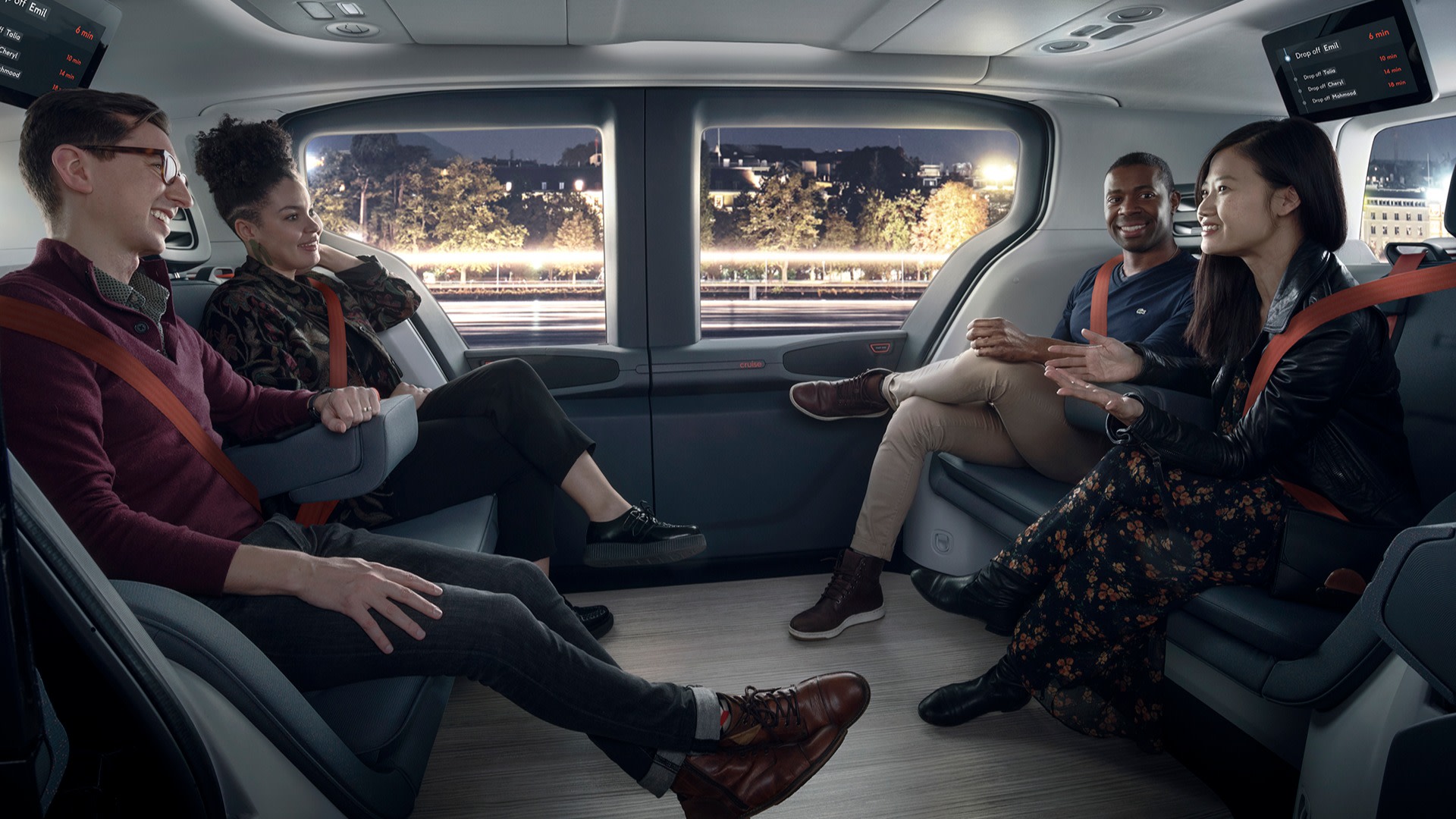
Moreover, the Origin is not innovation for its own sake. In the spirit of the U.S. Department of Transportation’s six guiding principles for work on innovation in transportation, the Origin is in service of something greater: driving environmental sustainability, ensuring U.S. leadership in developing and manufacturing autonomous technology and artificial intelligence, supporting the American workforce, and promoting accessibility.
Every Origin will be a zero-emission, shared, electric vehicle — helping to reduce the nation’s reliance on oil, as well as the emissions that disproportionately burden historically underserved communities. The Origin will help expand mobility options for seniors, people who are blind or have low vision, and other communities that have traditionally faced barriers in access to reliable transportation. And the Origin will be manufactured at GM’s Michigan Factory ZERO, supporting and creating American jobs, promoting economic growth, and advancing the long-term success of the U.S. manufacturing sector and America’s automotive industry.
The submission of this petition signals that Cruise and GM are ready to build and deploy the Origin, here in America. We look forward to NHTSA’s thorough review of our petition, and stand ready to continue working closely with them to ensure the safe and responsible deployment of this technology.
HONDA The Power of Dreams .cls-1,.cls-2{stroke-width:0px;}.cls-2{fill:#c00;}
- News Release
Honda, GM and Cruise Plan to Begin Driverless Ridehail Service in early 2026
– The Three Companies Enter Memorandum of Understanding Aiming to Establish a JV Company to Provide Driverless Ridehail Service in Japan –

TOKYO, Japan, October 19, 2023 – Cruise, General Motors Company (GM) and Honda Motor Co., Ltd. (Honda) today announced that they have entered into a Memorandum of Understanding aiming to establish a joint venture which will begin a driverless ridehail service in Japan in early 2026. The three companies aim to establish this new company in the first half of 2024 pending regulatory approvals.
<Overview of the service>
With this new service, the Cruise Origin, jointly developed by GM, Cruise and Honda and purpose built for a driverless ridehail service, will come pick up the customers at a specified location and drive them to the destination, entirely through self-driving. Customers will use a dedicated app on their smart phones to complete the entire process from hailing to payment.
The Cruise Origin is a self-driving vehicle with no driver’s seat or steering wheel. It features a vast cabin space that can be as private as a personally-owned vehicle and that allows 6 people to ride simultaneously, facing-to-face. This driverless ridehail service will offer an entirely new kind of mobility experience in Japan and target a wide range of customers, including business people, families, visitors and more.
The three companies are planning to launch the driverless ridehail service in central Tokyo in early 2026. The service will start with dozens of Cruise Origins, and then expand to a fleet of 500 Cruise Origins. The three companies plan to subsequently expand and scale the service to areas outside of central Tokyo.
<Collaboration with relevant industries>
Through this driverless ridehail service, the three companies will strive to offer a new value of mobility, while also helping address societal issues facing Japan, such as the taxi and bus driver shortage. Honda and the new JV company will continue to strengthen coordination and collaboration with various stakeholders, including local municipal governments and transportation service providers.
The Cruise Origin is scheduled to be on display for the first time in Japan at the Honda booth at the JAPAN MOBILITY SHOW 2023 at Tokyo Big Site (Public days: October 28 – November 5, 2023).
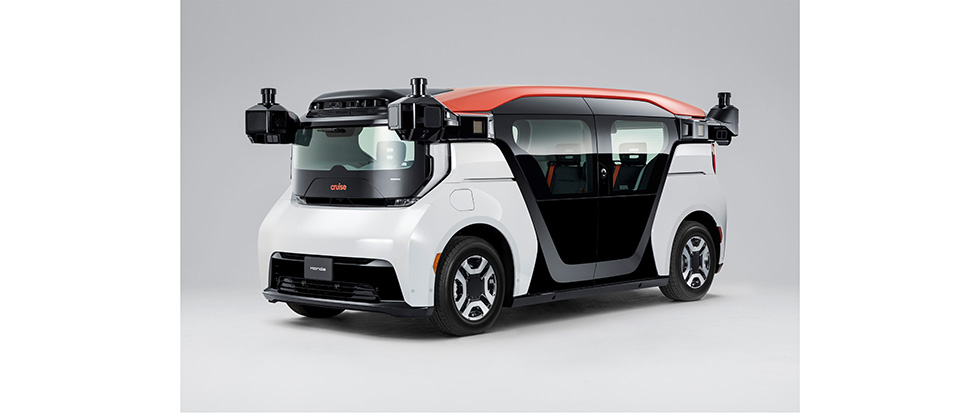
■Comments by Kyle Vogt, Founder and CEO of Cruise
“Honda has been a key partner with Cruise for several years and we’re excited to offer safer and more accessible transportation to customers in Tokyo. All of our work scaling in dense urban US markets will position us well to address the huge opportunity for autonomous vehicles in Japan.”
■Comments by Mary Barra, Chair and CEO of GM
“GM has always been invested in defining the future of transportation and that’s more true today than ever. The benefits of AVs – from safety to accessibility – are too profound to ignore and through this important partnership with Cruise and Honda, we’re bringing forward innovation that leverages our expertise in cutting-edge software and hardware to help more people around the world get where they need to go.”
■Comments by Toshihiro Mibe, Global CEO of Honda
“Honda is striving to create the ‘joy and freedom of mobility.’ Through our driverless ridehail service, we will enable customers in Japan to experience a new value of mobility, improve the quality of their mobility experiences and offer the joy of mobility. This will be a major step toward the realization of an advanced mobility society. Providing this service in central Tokyo where the traffic environment is complex will be a great challenge, however, by working jointly with Cruise and GM, Honda will exert further efforts to make it a reality.”
Watch CBS News
"Extreme" G5 geomagnetic storm reaches Earth, NOAA says, following "unusual" solar event
By Li Cohen
Updated on: May 11, 2024 / 8:32 PM EDT / CBS News
An "extreme" G5 geomagnetic storm reached Earth on Friday, NOAA's Space Weather Prediction Center said , after issuing a watch earlier in the day warning of the potential for a severe impact.
The watch followed days of solar activity that sent several explosions of plasma and magnetic fields toward Earth.
G5 is the strongest level of geomagnetic storm , on a scale from G1 to G5.
"Widespread voltage control problems and protective system problems can occur," NOAA warns. "Some grid systems may experience complete collapse or blackouts. Transformers may experience damage."
Radio transmissions and satellite navigation may also be disrupted.
The last G5 geomagnetic storm, in October 2003, caused power outages in Sweden and damaged transformers in South Africa.
A geomagnetic storm also means aurora borealis , otherwise known as the northern lights , could be seen as far south as Alabama and in Northern California.

Earlier, NOAA had issued its first watch for a potential G4-level geomagnetic storm in almost 20 years. "If geomagnetic storms were hurricanes, 'severe' would be category 4," SpaceWeather.com says.
In a press release on Thursday, NOAA said the most recent series of solar events started on May 8, when a large cluster of sunspots produced "several moderate to strong solar flares." Solar flares are bursts of radiation known to be the solar system's largest explosive events, according to NASA. The area where the flares are occurring is 16 times the diameter of Earth, the NOAA said, and more solar activity is expected.
That sunspot is so big you may be able to see it with your own eyes — with your solar eclipse glasses. The spot is known as AR3664 , and it was responsible for most of the geomagnetic activity Friday, the NOAA reported. According to Space.com, it measures about 124,000 miles across and is one of the "largest and most active sunspots seen this solar cycle."
The NOAA reported that a strong solar flare was observed peaking from AR3664 at 9:23 p.m. Eastern Time Friday.
"Flares of this magnitude are not frequent," the prediction center said .
Still have your solar eclipse glasses? There's currently a sunspot so large you will be able to "spot" it while wearing them 15x wider than the earth! pic.twitter.com/XpQJEd4Qk0 — Eric Fisher (@ericfisher) May 9, 2024
There has also been a series of coronal mass ejections (CMEs), which are explosions of plasma and magnetic fields that come out of the sun's corona, the outermost part of the sun's atmosphere. At least five CMEs appear directed toward Earth and could arrive as early as midday on Friday and persist through Sunday, the agency said.
"This is an unusual event," NOAA said.
In a call with reporters on Friday, Shawn Dahl, service coordinator at the Space Weather Prediction Center, said that some CMEs "are catching up with other ones." He said officials are expecting a "big shock arrival" when they hit Earth. Dahl said at the time that while officials weren't predicting a G5 storm — the strongest of geomagnetic storms — they couldn't discount a "low-end G5 event."
"We're really buckling down here," Brent Gordon, chief of the space weather services branch, also said on the call.

G4 conditions were detected by Friday afternoon, marking a "major disturbance in Earth's magnetic field," NOAA said, adding that "the public should stay properly informed of storm progression."
In a forecast discussion at 12:30 p.m. on Friday, NOAA's Space Weather Prediction Center said that solar activity is expected to continue at "high to very high levels" through the weekend, with additional solar flares expected, including X-class flares , the most powerful class of solar flares.
As of Friday afternoon, NOAA said it had observed a moderate solar radiation storm that could expose people in high-flying aircraft to "elevated radiation risk" and cause infrequent issues with satellite operations.
Radio blackouts have also been detected with an R3 designation, meaning that the blackouts were "strong" on a scale from R1 (minor) to R5 (extreme). At this level, wide blackouts of HF radio communication is expected, as well as loss of radio contact, for about an hour on the sunlit side of Earth, as low-frequency navigation signals decline for roughly an hour.
"Geomagnetic storms can impact infrastructure in near-Earth orbit and on Earth's surface, potentially disrupting communications, the electric power grid, navigation, radio and satellite operations," NOAA said. "[The Space Weather Prediction Center] has notified the operators of these systems so they can take protective action."
Dahl agreed Friday that the event is "pretty extraordinary" and said that it could impact infrastructure, including high-voltage transmission lines of the power grid. Dahl said that infrastructure operators have been notified to adequately prepare.
This is the first time a storm watch has been issued for a G4 since January 2005. There is an average of 100 severe geomagnetic storms every solar cycle, but so far, there have only been three observed in the most recent cycle that began in December 2019. The most recent occurred on March 23.
- National Oceanic and Atmospheric Administration

Li Cohen is a social media producer and trending content writer for CBS News.
More from CBS News

Solar storms can affect electronics and the power grid – an expert explains

Huge billboard toppled by storm kills more than a dozen people in India

Mixed-breed dog wins Westminster's agility competition for first time

Summer 2023 was the hottest in 2,000 years, study finds
Blue Origin will launch these 6 passengers May 19, on its 1st crewed mission since 2022
The crew includes the United States' 1st-ever Black astronaut candidate, who never made it to space.

Blue Origin is set to break its dry spell of crewed launches this weekend.
A crew of six will be aboard Blue Origin's New Shepard rocket-capsule combo on the company's 25th overall launch and seventh space tourism mission, which will lift off from West Texas. The passengers on this flight, known as NS-25, were announced last month ; they include retired U.S. Air Force Capt. Ed Dwight, who was selected as the nation's first Black astronaut candidate way back in 1961.
Blue Origin, run by billionaire Jeff Bezos , did not initially indicate a date for the NS-25 mission, but announced earlier this week that the launch is targeted for this Sunday (May 19) at 9:30 a.m. EDT (1330 GMT; 8:30 a.m. local time in West Texas).
Related : Blue Origin will launch Ed Dwight, the 1st-ever Black astronaut candidate, to space on next New Shepard rocket flight
Blue Origin's last space tourism launch occurred in August 2022. That mission carried six passengers on a suborbital flight just like the one scheduled for this weekend and performed nominally, with both the New Shepard rocket and the crewed capsule landing safely.
However, the next New Shepard flight — an uncrewed research mission that launched in September 2022 — suffered an anomaly caused by a structural failure in the nozzle of the rocket's BE-3PM engine. The capsule for that launch managed to parachute safely back to the ground, but the New Shepard rocket exploded, leading Blue Origin to ground the vehicle as the company performed an investigation.
More than a year later, New Shepard was cleared for flight again, and launched another uncrewed payload on the NS-24 mission in December 2023. This weekend, the six passengers of NS-25 will be the first crew to launch on New Shepard since its accident almost two years ago.
Get the Space.com Newsletter
Breaking space news, the latest updates on rocket launches, skywatching events and more!

Ed Dwight is a retired U.S. Air Force Captain. In 1961, he was recommended for training at the Aerospace Research Pilot School (ARPS) by President John F. Kennedy, according to Blue Origin's NS-25 mission page . Ultimately, however, NASA did not accept Dwight into the Astronaut corps. He entered civilian life in 1966, retiring from the military to eventually become a sculptor dedicated to memorials and public arts celebrating Black history across the United States and Canada. Dwight's seat aboard NS-25 was sponsored by the Jaison and Jamie Robinson Foundation and Space for Humanity , a nonprofit geared toward making space more accessible for all of humanity.

Mason Angel founded Industrious Ventures, a venture capital fund that supports companies playing a role in the "transformation of fundamental industries and processes," according to Industrious Ventures' website . His biography on Blue Origin's mission page states that Angel hopes his NS-25 mission will "inspire children and advance partnerships with nonprofits focused on STEM [science, technology, engineering and math] in early education." The dog in Angel's photo is named Leo, a nod to low-Earth orbit .

Sylvain Chiron may well be cheering his mission to space with a beer made by Brasserie du Mont Blanc , one of France's largest craft breweries. Chiron founded the brewery in 1999. The French entrepreneur's love of aerospace goes way back; he earned his pilot's license at 16 years old and spent summers in Florida honing those flight skills and watching space shuttle launches from the Space Coast. According to his Blue Origin bio, Chiron currently resides with his family in Savoy, France, where he focuses his efforts on children's education and nature preservation.

Ken Hess rose to the entrepreneurial top with his Family Tree Maker software, which he sold to Ancestry.com in 2003. With his success, Hess was able to found the children's STEM education nonprofit Science Buddies to improve science literacy in grades K-12. According to Blue Origin's website, Science Buddies has reached 250 million users.

Carol Schaller lives on a farm in Lumberville, Pennsylvania, with her husband, and when she isn't tending to her 100 chickens, she is busy on her mission to see the world. Schaller was informed by her doctor in 2017 that she would eventually go blind, and since that diagnosis has traveled to 25 different countries and the South Pole. Now, she will get to look at space with her own two eyes. "Seeing Earth’s thin layer of atmosphere in the blackness of space will fulfill a lifelong dream," Blue Origin wrote on its NS-25 mission page.

Gopi Thotakura is co-founder of Preserve Life Corp, an Atlanta-based global center for holistic health and wellness. Thotakura graduated from Embry-Riddle Aeronautical University and is a practiced pilot of several non-military aircraft, including gliders, seaplanes and hot air balloons. His Blue Origin biography also indicates that Thotakura has served as an international medical jet pilot.
— Facts about New Shepard, Blue Origin's rocket for space tourism
— In photos: William Shatner launches to space on Blue Origin's New Shepard
— Blue Origin launches Michael Strahan and crew of 5 on record-setting suborbital spaceflight
Join our Space Forums to keep talking space on the latest missions, night sky and more! And if you have a news tip, correction or comment, let us know at: [email protected].

Josh Dinner is Space.com's Content Manager. He is a writer and photographer with a passion for science and space exploration, and has been working the space beat since 2016. Josh has covered the evolution of NASA's commercial spaceflight partnerships, from early Dragon and Cygnus cargo missions to the ongoing development and launches of crewed missions from the Space Coast, as well as NASA science missions and more. He also enjoys building 1:144 scale models of rockets and human-flown spacecraft. Find some of Josh's launch photography on Instagram and his website , and follow him on Twitter , where he mostly posts in haiku.
India makes breakthrough by test-firing new 3D-printed rocket engine (photo)
Blue Origin targeting May 19 for 1st crewed spaceflight since 2022
SpaceX stacks Starship megarocket ahead of 4th test flight (video, photos)
Most Popular
- 2 Doctor Who 'Space Babies': Why is The Doctor alone in the universe?
- 3 Japanese-European spacecraft bound for Mercury weakened by thruster glitch
- 4 Stephen Hawking Medal 2024 winners announced at star-studded Starmus VII festival
- 5 India's space agency has been carefully watching our sun's solar tantrums
More From Forbes
Baidu launches new $28,000 robotaxi in wuhan.
- Share to Facebook
- Share to Twitter
- Share to Linkedin
New 6th generation Baidu Apollo Go robotaxi in China
Baidu, the tech company sometimes called the “Google of China” announced its new 6th generation robotaxi, with plans to deploy 1,000 of them in Wuhan this year. They also forecast they will be profitable in 2025 (on a “unit economy” basis, a type of gross margin.) The new vehicle, which costs them 200,000 RMB to build (around $27,500 USD) is half the cost of their previous generation vehicle.
While the new vehicles retain a wheel and pedals, they will operate without safety drivers in Wuhan, where 70% of Baidu Apollo Go’s robotaxi operations currently are without a safety driver, according to the company.
They are also lowering costs by automating a lot of their depot operations. These vehicles use automatic battery swap to recharge, and Apollo Go states that vehicle activation, dispatch, cleaning and retrieval will all be done without human intervention. On the software side, they announced a new foundation model (AI technology) will now be doing the driving, and is flexible enough to deploy in new cities with about 6 months of effort.
While Chinese car economics are different from those in the west, and Chinese EVs cost less than in the USA, the ability to put together a nice EV along with all the compute and sensor suite for under $28,000 is a big step, and will eventually be duplicated around the world. Once you get the other factors of a robotaxi service (such as those depot operations listed) to work at scale, the largest cost of operating a robotaxi derives from depreciation of the vehicle, so the lower the vehicle cost, the lower the cost per ride. (This differs from regular taxis where the human driver is the largest cost.) In fact, once you start removing features for the driver (like wheels, pedals, adjustable seats and a complex dashboard) a robotaxi can cost less to make than a consumer car.
Indeed this vehicle—though made to Chinese standards and pricing—undercuts the likely forecast price for the “Tesla Model 2” which Tesla recently put on the backburner in favor of a robotaxi. Chinese standards are improving, but there is one snag in bringing those lower costs to the USA—a planned 100% tariff on EV import from China. But even at double the price, this vehicle is cheaper than any planned robocar in the USA. Today, US consumers don’t know and can’t buy Chinese brands, and they may take some time to do so, but those rules don’t apply to robotaxis. Indeed, Waymo has contracted with Zeekr, a unit of Chinese auto giant Geely, to build their next generation robotaxi. Taxi customers don’t really care about what nameplate is on their taxi. They will care about the Waymo/Google brand or Uber brand, but not about what’s underneath. It could easily be a Chinese brand they’ve never heard of.
Japanese Fans Are Puzzled That Yasuke Is In ‘Assassin’s Creed Shadows’
Forbes releases 2024 30 under 30 asia list, kamala harris raked in interest income in 2023 new filing shows.
In fact while an imported robotaxi must not have any significant safety issues, the same standard does not apply on mechanical reliability and quality. When a consumer car breaks down, the owner is greatly inconvenienced and angry. If a robotaxi breaks down or has a quality problem, it’s just taken out of service. If passengers were in it, it pulls over and a new taxi arrives in 60 seconds to continue them on their way—almost no inconvenience at all. As such, Chinese quality standards in low cost vehicles may well already be high enough for the western markets.
Battery swap is not reasonable for consumer cars, but can be a good choice for robotaxi fleets. It will be interesting to see just how they will automate cleaning—I have reached out to Baidu for comment on that.
Robocar and automaker players outside China must take notice. Right now Waymo is dominating the space outside China, but a tiger is waiting to strike. Due to current politics, it is unlikely the USA and other countries would let a Chinese based company command and operate a robotaxi fleet in the USA, but once the Chinese companies seek to expand, they will find non-Chinese partners to deploy their technology, and a tiger may be ready to pounce.

- Editorial Standards
- Reprints & Permissions
Join The Conversation
One Community. Many Voices. Create a free account to share your thoughts.
Forbes Community Guidelines
Our community is about connecting people through open and thoughtful conversations. We want our readers to share their views and exchange ideas and facts in a safe space.
In order to do so, please follow the posting rules in our site's Terms of Service. We've summarized some of those key rules below. Simply put, keep it civil.
Your post will be rejected if we notice that it seems to contain:
- False or intentionally out-of-context or misleading information
- Insults, profanity, incoherent, obscene or inflammatory language or threats of any kind
- Attacks on the identity of other commenters or the article's author
- Content that otherwise violates our site's terms.
User accounts will be blocked if we notice or believe that users are engaged in:
- Continuous attempts to re-post comments that have been previously moderated/rejected
- Racist, sexist, homophobic or other discriminatory comments
- Attempts or tactics that put the site security at risk
- Actions that otherwise violate our site's terms.
So, how can you be a power user?
- Stay on topic and share your insights
- Feel free to be clear and thoughtful to get your point across
- ‘Like’ or ‘Dislike’ to show your point of view.
- Protect your community.
- Use the report tool to alert us when someone breaks the rules.
Thanks for reading our community guidelines. Please read the full list of posting rules found in our site's Terms of Service.

IMAGES
COMMENTS
Autonomous vehicle developer Cruise debuted the Cruise Origin, its new vision for a totally driverless, emissions-free vehicle of tomorrow, at an event in San Francisco Tuesday night. And yes, it ...
Getting in the right van, motion sickness, seeing in the dark among challenges tackled. We've now seen the funky Cruise Origin self-driving vehicle, and GM has confirmed it will start building the ...
Cruise, the self-driving subsidiary of General Motors, revealed its first vehicle to operate without a human driver, the Cruise Origin. The vehicle, which la...
The Cruise Origin shown this week is a boxy, van-like vehicle and there is a clear difference between front and back, in part to help other cars with retro features (that is, human drivers) cue ...
It uses the self-driving car based on the Chevy Bolt, as the Cruise Origin hasn't been deployed yet. Alphabet's Waymo division began providing its self-driving ride-hailing service in San ...
Cruise first unveiled the Origin robotaxi in early 2020 as a bus-like vehicle built for the sole purpose of shuttling people around in a city autonomously. But since then, the company has been ...
Cruise Unveils Origin, a Self-Driving Vehicle with No Steering Wheel or Pedals. This autonomous electric minivan is meant to make Uber, Lyft, and commuting in a personal car obsolete. Cruise ...
The Cruise Origin driverless car is roughly the same size as a traditional crossover utility vehicle, with a boxy body and two-tone color scheme. Ingress is achieved via an exterior-mounted keypad ...
Jan 21, 2020 at 10:04pm ET. By: Domenick Yoney. Today, self-driving car service Cruise launched its first fully autonomous, all-electric vehicle in San Francisco: the Cruise Origin. Not a concept ...
Phase three, the "rapid scaling phase," begins in 2023, when production of the Cruise Origin will begin at GM's Zero Assembly Plant, a factory dedicated to the production of electric vehicles.
Cruise says the electric vehicle will be deployed as part of a ride-hailing service, but declined to say when that might be. Skip to main content ... Cruise's Origin is a car.
See All 12 Photos. Cruise Automation, a self-driving tech startup, was founded in 2013 and bought by General Motors in 2016. GM remains a majority shareholder, but Cruise (it has dropped ...
History. Cruise initially focused on developing direct-to-consumer kits to retrofit vehicles with limited self-driving capabilities. The earlier generation of Cruise technology, RP-1, offered an autonomous on-demand feature available for the Audi A4 or S4 (2012 or later). The $10,000 kit is intended to eventually retrofit all vehicles into a highway autopilot system.
Now, Cruise is set to deploy Cruise Origin, a vehicle built from the ground up as a fully autonomous robotaxi specifically designed for ride hailing service. According to Cruise CEO Kyle Vogt ...
Cruise. The future of the auto industry isn't horsepower or style when it comes to autonomous vehicles and ride-sharing services. It's a box. The most recent proof of this came Tuesday night ...
The Cruise Origin is taking its next steps. Cruise has secured $5 billion with GM Financial to purchase thousands of Cruise Origin vehicles, and the first te...
This prompted California officials to indefinitely suspend the company's self-driving car permits on October 24. Cruise then put a pause on its operations, and two founding executives, CEO Kyle ...
Learn the basics of how a Cruise car navigates city streets safely and efficiently. Cruise 101. Look. Sensors can see 360 degrees, hundreds of feet ahead, and around that double-parked car. Cruise cars make sense of this data in a split second, tracking every important object in view. Cruise 101.
General Motors' mission to get 5,000 self-driving Cruise Origin vehicles in cities nationwide hangs on whether federal regulators will grant the automaker's request to exempt the vehicle from ...
Cruise's autonomous vehicles are officially back on the road and driving autonomously for the first time since one of its driverless vehicles dragged a pedestrian over 20 feet in San Francisco.
Cruise unveiled Tuesday evening a "production ready" driverless vehicle called Origin, the product of a multi-year collaboration with parent company GM and investor Honda that is designed for ...
Cruise ridehail services are not available at this time, but you can join the waitlist to be one of the first. Cruise is the leading self-driving car company driven to improve life in our cities by safely connecting people with places, things & experiences they love.
The Cruise Origin is among the most innovative vehicles in history: a zero-emission, shared, electric vehicle that has been purposefully designed from the ground up to operate without a human driver. This means it does not rely on certain human-centered features, like a steering wheel or a sun visor, to operate safely.
The Cruise Origin is a self-driving vehicle with no driver's seat or steering wheel. It features a vast cabin space that can be as private as a personally-owned vehicle and that allows 6 people to ride simultaneously, facing-to-face. This driverless ridehail service will offer an entirely new kind of mobility experience in Japan and target a ...
Simple to use, all you need to do is turn on the system in your vehicle, reach your desired cruising speed, and set it. The system then assumes control of the accelerator, maintaining the set ...
An "extreme" G5 geomagnetic storm reached Earth on Friday, NOAA's Space Weather Prediction Center said, after issuing a watch earlier in the day warning of the potential for a severe impact. The ...
Blue Origin will launch these 6 passengers May 19, on its 1st crewed mission since 2022. News. By Josh Dinner. published 16 May 2024. The crew includes the United States' 1st-ever Black astronaut ...
The new vehicle, which costs them 200,000 RMB to build (around $27,500 USD) is half the cost of their previous generation vehicle. While the new vehicles retain a wheel and pedals, they will ...